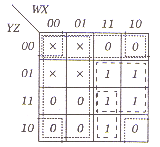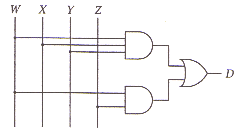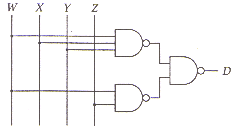| A water heater is
controlled by a device D that monitors four sensors W, X, Y , Z. If sensors W and Z both
signal 1, then device D should be on; otherwise, if sensor W signals 0 to sensor Y signals
1, then D should be off; otherwise, if sensors W, X, Y all signal 1, then D should be on;
otherwise, if sensor W signals 1 and sensor Z signals 0, then D should be off; otherwise
we don't care what the device does.
|
|||||||||||||||||||||||||||||||||||||||||||||||||||||||||||||||||||||||||||||||||||||||
| (a) | Give the truth-table for device D.
|
[3] | |||||||||||||||||||||||||||||||||||||||||||||||||||||||||||||||||||||||||||||||||||||
|
|||||||||||||||||||||||||||||||||||||||||||||||||||||||||||||||||||||||||||||||||||||||
| (b) | Give an unsimplified sum-of-products expression for the device D. | [1] | |||||||||||||||||||||||||||||||||||||||||||||||||||||||||||||||||||||||||||||||||||||
| _ _
_
_
_ WXYZ + WXYZ + WXYZ + WXYZ + WXYZ
|
|||||||||||||||||||||||||||||||||||||||||||||||||||||||||||||||||||||||||||||||||||||||
| (c) | Using a Karnaugh map, find the simplified sum-of-products and product-of-sum forms of this expression. | [7] | |||||||||||||||||||||||||||||||||||||||||||||||||||||||||||||||||||||||||||||||||||||
The Karnaugh map for
both forms is The grouping of the 1st is shown with longer dashes, and the grouping of the 0s with shorter dashes. Note that one grouping of the 0s wraps around all four corners. Hence the simplified sum-of-products form is WXY + WZ and the simplified product-of-sums is W(Y + Z)(X + Z)
|
|||||||||||||||||||||||||||||||||||||||||||||||||||||||||||||||||||||||||||||||||||||||
| (d) | Draw a circuit to implement the simplified sum-of-products above, using AND, OR and NOT. | [3] | |||||||||||||||||||||||||||||||||||||||||||||||||||||||||||||||||||||||||||||||||||||

|
|||||||||||||||||||||||||||||||||||||||||||||||||||||||||||||||||||||||||||||||||||||||
| (e) | Express the simplified sum-of-products form from part (c) using only NAND, and hence redraw the circuit using only NAND gates. | [4] | |||||||||||||||||||||||||||||||||||||||||||||||||||||||||||||||||||||||||||||||||||||
| We have and so the circuit is 
|
|||||||||||||||||||||||||||||||||||||||||||||||||||||||||||||||||||||||||||||||||||||||
| (f) | Why might the circuit in part (e) be preferable to the circuit in part (d)? What does this mean for the skills of a circuit designer? | [2] | |||||||||||||||||||||||||||||||||||||||||||||||||||||||||||||||||||||||||||||||||||||
| It may be cheaper or
easier to construct the circuit out of a single type of gate. A circuit designer must be able to design a circuit in more than one way. |
|||||||||||||||||||||||||||||||||||||||||||||||||||||||||||||||||||||||||||||||||||||||